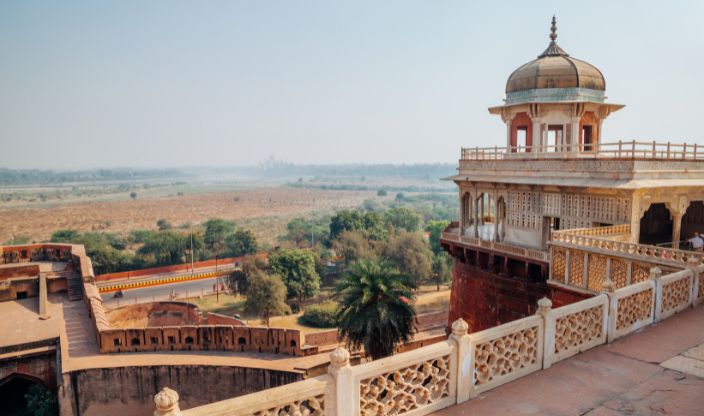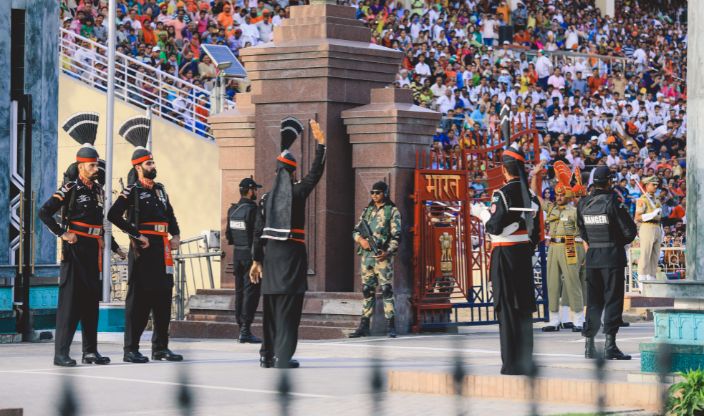Introduction
India and Pakistan share a rich and complex history, intertwined by centuries of political, cultural, and social exchanges. One of the most significant periods of this shared history is the Mughal Empire, which ruled over the Indian subcontinent for more than three centuries. The empire blended Mongol traditions, Persian high culture, and Islamic art with the richness and vitality of the Indian subcontinent. The Mughal Emperors left an indelible mark on the region’s art, architecture, cuisine, and culture, which can still be seen and experienced today.
Delve deeper into the history of India and Pakistan, tracing the footsteps of the Mughal Emperors and exploring the vibrant and diverse cultures of these two neighbouring countries. Through this tour of India and Pakistan, two successor nations of the empire, we will discover the lasting cultural influence of this dynasty that reached as far as the court of Queen Victoria.
At a Glance
Highlights

Visit four of the five Mughal capitals, including Delhi, Agra, Fatehpur Sikri, and Lahore, to witness the grandeur of the Mughal Empire. Each city boasts exquisite architecture, magnificent forts, and stunning mausoleums that showcase the magnificence and artistic prowess of the Mughal dynasty.

Experience the famous Wagah border ceremony, a daily military parade that takes place at the India-Pakistan border. The ceremony features a display of military drills and a lowering of the national flags of both countries, creating an electrifying atmosphere.

Admire the grandeur of Lahore’s Royal Fort, a majestic monument built during the Mughal era with intricate artwork, stunning courtyards, and impressive gates.

Multan’s Kashikari glazed pottery is a renowned craft that has been passed down through generations. Witness the skilled artisans shaping, painting, and glazing each piece by hand in their workshops, creating intricate and vibrant designs that are a testament to their mastery of the art form.
Sample Itinerary
Discovering the Legacy of the Mughals throughout India and Pakistan: A Sample Itinerary
This itinerary takes you on a fascinating journey through the sacred sites and historical landmarks of two neighbouring countries, India and Pakistan. Discover the vibrant city of Delhi, the spiritual Ram Bagh garden, the breathtaking Taj Mahal, and the iconic Golden Temple. Witness the unique Changing of the Guard ceremony at the Wagah border, then cross the border to Pakistan, where you will immerse yourself in the rich cultural heritage of Lahore, visiting the Badshahi Mosque, Royal Fort, Wazir Khan Mosque, and Shahi Hammam. Explore the ancient cities of Harappa and Uch Sharif, and the historic riches of Multan. The treasures of the Mughal Empire are waiting to be discovered by you.
Begin your journey by taking an overnight flight from London to Delhi via Dubai.
(Flight Included | Airport Transfer | N)
Upon arrival in Delhi, check-in at the Maidens Hotel for a 3-night stay. Settle in and freshen up and in the afternoon, enjoy an introductory lecture and a welcome dinner.
(D)
Today, begin your 2-day tour of Delhi. On this tour, you will explore some of Delhi’s fascinating pre-Mughal and early Mughal sites, which existed before the establishment of Shahjahanabad, now known as Old Delhi.
The first stop is the Qutb Minar complex, a UNESCO World Heritage Site that dates back to the 12th century. This complex was built on the foundations of Jain and Hindu temples and is known for its impressive 73-meter-tall minaret. In addition to the minaret, the complex features several other beautiful structures, including the Alai Darwaza gate, the Quwwat-ul-Islam Mosque, and the Iron Pillar. Next, visit the Hauz Khas Complex, located in the heart of a neighbourhood in South Delhi that features a beautiful lake, charming gardens, and other historical structures including a mosque and a tomb.
After that, proceed to the tomb of Humayun, the second Mughal Emperor. This stunning mausoleum was built in the 16th century and is a prime example of Mughal architecture. The tomb is set within beautiful gardens and is adorned with intricate tile work and delicate carvings. In the afternoon, a local specialist will give an exclusive lecture about Mughal art at Intach’s office (subject to confirmation). This lecture will provide a fascinating insight into the artistic styles and influences of the Mughal era.
(B)
Continue exploring Delhi and embark on a full-day tour of Shahjahanabad, also known as Old Delhi. The first visit is to the Red Fort, a UNESCO World Heritage Site that served as the main residence of the Mughal emperors for nearly 200 years. The fort is an impressive example of Mughal architecture and features structures, including the Diwan-i-Aam and the Diwan-i-Khas. Next, visit Jama Masjid, the largest mosque in India, which can accommodate up to 25,000 worshippers. This beautiful mosque was built in the mid-17th century by the Mughal emperor Shah Jahan and is a fine example of Mughal architecture.
After that, continue to the Fatehpuri Masjid complex, a beautiful mosque that was built in the 17th century by Fatehpuri Begum, one of Shah Jahan’s wives. Also, visit the Qudsia Bagh mosque, which was built in the 18th century by the Mughal Empress Qudsia Begum, the wife of Mughal Emperor Muhammad Shah.
Finally, visit the tomb of Abdul Rahim Khan, a symbol of love which was built in 1598 by Abdul Rahim Khan-i-Khana for his wife, Mah Banu. Abdul Rahim Khan was a prominent minister in the court of Mughal Emperor Akbar and was known for his literary and artistic talents. The tomb is built in red sandstone with intricate carvings and inscriptions, and is surrounded by a lush garden.
(B)
Enjoy breakfast then leave Delhi and head to Agra. On the way, make a stop at Sikandra on the outskirts of Agra, to visit the tomb of the Mughal Emperor Akbar. This stunning pyramidal, five-storey structure surrounded by a beautiful garden was designed by Akbar himself and is a prime example of Mughal architecture. Continue the drive to Agra and spend 2 nights at ITC Mughal.
(B)
Today, explore Agra through a full-day tour. Start with the Red Fort, a massive fort that was built in the mid-16th century and served as the main residence of the Mughal emperors for nearly a century. The fort affords a spectacular view of the Taj Mahal, which sits gracefully in the landscape just across the river.
Next, visit the Tomb of I’timad-ud-Daulah, often referred to as the “baby Taj” due to its striking resemblance to the Taj Mahal. This beautiful mausoleum was built in the mid-17th century and features stunning marble work and intricate inlay designs.
The tour will also take you to Chinika Rauza, a beautiful mausoleum overlooking the Yamuna River which was built in the early 17th century for the Persian scholar and poet, Afzal Khan Shirazi. Finally, visit the Ram Bagh, “the garden of relaxation” India’s oldest Mughal garden, which was designed to encapsulate the Islamic idea of paradise with its splendid intersecting pathways and canals extending through the lush greenery.
Enjoy the remainder of the day at the Taj Mahal, widely regarded as the greatest architectural achievement among the Indo-Islamic architecture. Commissioned by Mughal Emperor Shah Jahan as a mausoleum for his beloved wife Mumtaz Mahal, the Taj Mahal is a magnificent structure is made entirely of ivory-white marble. The aesthetic aspect of this architectural marvel is enhanced by its rhythmic combination of solids and voids, concave and convex shapes, and the interplay of light and shadow. Additionally, features like arches and domes contribute to its overall beauty. It is considered a symbol of love and devotion and is often called the “crown of palaces”.
(B, L)
Start the day with a drive to Fatehpur Sikri, the former capital of the Mughal Empire built in the late 16th century by Emperor Akbar. The complex features a unique blend of Hindu and Islamic architecture and is known for its impressive red-sandstone buildings, including the Jama Masjid, Diwan-i-Aam, and Panch Mahal. Although only occupied for a brief period, the site remains a testament to the power and grandeur of the Mughal Empire.
In the evening, go to the Delhi airport to catch a flight to Amritsar where you will be staying for 2 nights at the Hyatt Regency.
(B)
Experience the awe-inspiring Golden Temple on a morning visit, with its full golden dome gleaming in the sunlight. The upper section of this sacred Sikh temple is adorned with about 400 kg of gold leaf, while the surrounding Amrit Sarovar is a sacred pond that purifies devotees of their karma. The temple also houses the largest free community kitchen (langar) in the world, serving about 100,000 people daily.
Next, explore Qila Ahluwalia, a colonial-era fortress that protected the Golden Temple and Katra. After that, have some crispy sticky sweet snacks at the jalebi sweet shop at Jalebiwala Chowk. Late afternoon, head to Wagah on the India-Pakistan border for the unique Changing of the Guard Ceremony. Watch as the sun sets, the border’s iron gates open and soldiers from both sides lower and fold their flags in unison before shaking hands and retreating. Then, the gates are closed.
(B)
After breakfast, depart your hotel and head to Wagah to cross the India-Pakistan border. After completing the formalities at the border, meet your guide in Pakistan and make your way to the city of Lahore, the cultural capital of Pakistan. On the way, visit the breathtaking Shalimar Gardens, an artistic Mughal garden complex built in the 17th century with to create an earthly utopia representation where humans and all the elements of nature co-exist in perfect harmony. Check-in at Faletti’s Hotel, Lahore for a 3-night stay.
(B)
Spend a full day exploring Lahore, the historic capital of both the Mughal Empire and the Punjab region. A highlight of the city is the Badshahi Mosque, built in 1673 by the Mughal Emperor Aurangzeb and is one of the largest mosques in the world. The mosque features intricate marble work, frescoes, and calligraphy. Another historic landmark in Lahore is The Royal Fort, also known as the Lahore Fort. Constructed during the 16th century, this fort functioned as the dwelling place of the Mughal emperors. The fort features stunning architecture, including the Sheesh Mahal, a palace decorated with thousands of small mirrors.
Visit the Wazir Khan Mosque, a beautiful mosque located in the heart of Lahore. It was built in the 17th century by the Mughal governor of Lahore, and it is known for its intricate tile work and frescoes. Finally, visit the Shahi Hammam, also known as the Royal Bath, a historic bathhouse constructed in a Persian style. The walls and ceilings are adorned with geometric and floral patterns, creating a stunning visual display. It was built in the 17th century and served as a public bath for the people of Lahore. The bathhouse features stunning architecture and intricate tilework.
(B)
In the morning, visit the tomb of Emperor Jahangir, a magnificent mausoleum located in Shahdara, a suburb of Lahore, Pakistan. Built in the early 17th century, the tomb is a splendid example of Mughal architecture surrounded by beautiful gardens and a water pond, adding to its serene and peaceful ambience. The tomb houses the remains of Emperor Jahangir, the fourth Mughal emperor, and is the only mausoleum of a Mughal emperor to be located in Pakistan. From there, continue to the nearby tomb of Jahangir’s favourite wife, Nur Jahan, who was a powerful empress and a skilled administrator. Her tomb is also a fine example of Mughal architecture and features intricate carvings and inlaid work.
In the afternoon, explore the cultural richness of Lahore with a visit to the Lahore Museum, which is home to an array of impressive Mughal artefacts. This museum is a treasure trove of ancient and modern exhibits, including ancient manuscripts, sculptures, and paintings. It is also known for its collection of rare coins and Gandhara art. The Lahore Museum is famously mentioned in the works of Rudyard Kipling.
Conclude your day’s tour with a visit to the vibrant Anarkali Bazaar, which dates back to the reign of Emperor Akbar the Great. This vibrant and colourful market is a shopper’s paradise, filled with traditional crafts, souvenirs, and textiles. Take a stroll through the winding lanes and enjoy the atmosphere of the lively marketplace.
(B, L)
Next, depart from Lahore and make your way to the historic city of Multan located in the Punjab province of Pakistan. On your way, make a stop to visit Harappa, an archaeological site located, dating back to the Indus Valley civilization. It is believed to have been one of the earliest urban settlements on the Indian subcontinent and offers a fascinating insight into the life and culture of the ancient Harappan people who lived here over 5000 years ago.
Upon arrival in Multan, visit a Kashikari pottery workshop, a style of pottery that originated in Multan during the Mongol invasions of the 13th century. The pottery is known for its intricate designs and beautiful colours and is still produced by skilled artisans today. Observe the skill of the potters as they work and perhaps even try creating your own piece.
Afterwards, check-in at Faletti’s Grand Multan for a 3-night stay. You can opt for an optional afternoon visit to the tomb of Shah Rukhn-e-Alam, a beautiful shrine located in Multan, dedicated to the Sufi saint Shah Rukhn-e-Alam. The shrine is a peaceful oasis in the bustling city of Multan and is also known for its mesmerizing Sufi music performances by local musicians.
(B)
In the morning drive to Uch Sharif, in the southern part of Pakistan’s Punjab province. It is believed that Alexander the Great founded the city during his conquest of the region. Over the centuries, Uch Sharif became an important centre of Islamic culture and education. Many Sufi saints are buried here, and their shrines continue to be popular pilgrimage sites for Muslims. The city was also a key centre of political power during the medieval period, and its strategic location made it a target for invasions by various armies.
Explore the famous Sufi shrines of the city, including the Tomb of Bibi Jiwandi, which is currently striving to receive full UNESCO World Heritage recognition. This tomb is considered to be one of the most significant examples of pre-Mughal architecture in the country. After the tour, return to Multan.
(B, L)
In the morning, explore Multan city, often referred to as the “City of Sufis” due to its abundance of Sufi shrines. You will have the opportunity to visit several of these historic shrines. Multan is considered one of the most important centres of Islamic learning in the subcontinent. Also, explore the Shahi Eid Gah mosque, a stunning example of later Mughal architecture, completed in the mid-18th century. The mosque is located in the heart of Multan and is known for its large open courtyard and elegant minarets.
In the afternoon, you can either spend your time leisurely or opt for a visit to the Multan Arts Bazaar, a vibrant marketplace located in the heart of the city. Here, you can explore a wide variety of traditional handicrafts, including Multani pottery, camel skin products, and intricate embroidery.
(B, L)
Depart from Multan and head towards Shekhepura, for a visit to the impressive Hiran Minar, a unique tower located in the heart of a royal hunting ground. Built in the early 17th century, the Hiran Minar served as a hunting lodge for Emperor Jahangir and commemorates his favourite antelope named Mansraj. Emperor Jahangir was known for his love of wildlife and patronage of the arts, which is reflected in the construction of the Hiran Minar. The architecture of Hiran Minar is characterized by its distinctive combination of Mughal and Persian styles, adorned with intricate floral patterns and calligraphic inscriptions. The complex comprises a large water tank surrounded by a circular rampart and a 100-foot-high Minar, or tower. The Minar features 108 holes, believed to have been used for bird hunting.
Later in the day, proceed to Lahore, where you will have a farewell dinner. Spend the night at the Faletti’s Hotel.
(B, D)
In the morning, bid farewell to Pakistan and head to the Lahore airport to board a flight to London via Dubai.
(Flight Included | Airport Transfer )

















